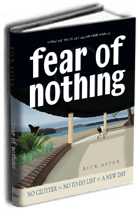I wrote about getting unstuck, and I thought I might lend extra emphasis to my point by providing a physical example. It often pays to consider the literal meaning of words when you’re trying to get at the true meaning. A vehicle is stuck when one or more of the tires is on a surface so slippery, whether by snow, ice, mud, or something else, that the ordinary mechanism of driving forward no longer suffices to get over the next small obstacle.
As long as you are stuck in this fashion, you can’t make any progress until you get unstuck. To get a vehicle unstuck, you may have to go backward or attempt some other alternate strategy just to move the next few inches forward, after which you may be able to proceed in a normal fashion.
Now let me relate this to the way people often approach new year’s resolutions or any other major goal-setting exercise. Imagine I am trying to go from Erie to Cleveland. On a good day that can be a one-hour drive, but there is more than the usual amount of snow on the roads, so I have to go slower than usual, and then my car gets stuck in the snow. There is a clump of hard snow ahead, but the tires are slipping in the snow and can’t provide enough push to get over this obstacle.
Now suppose I approach this problem the way people most often approach new year’s resolutions. I would notice I’m stuck and say, “Going to Cleveland must not have been a big enough goal. Why can’t I go to Toledo, or even Detroit?” I try to get unstuck by picking a destination that is two or three times as far.
Maybe imagining the things I could do in Detroit will “motivate” me to get the car moving again, but I hope you can see how far-fetched this approach would be. Gathering all the energy I can manage, I raise my fist and declare “Detroit or bust!” while my car refuses to go another inch forward through the snow toward the Pennsylvania-Ohio state line.
A better approach if I want to get moving again is to focus on my immediate situation. What snow or ice is under the wheels? Which tire is most stuck? Can I back up and go around the obstacle? Can I shovel out enough snow from under one tire that the car will move again? Do I need to put a sheet of newspaper under one tire to improve the traction?
After I get the car moving again, I am in a better position to choose where I want to go. I might continue on to my original destination, or I might well decide that it is not the right day to travel.
Supposing I use the vision of Detroit to keep myself moving as I go through the process of getting my car unstuck, that specific stated goal is still quite unlikely to get me to Detroit. It might serve to get me unstuck, but if by an extraordinary effort I finally get to Cleveland, I will surely want to stop there.
That’s what tends to happen whenever people use goal-setting to get unstuck. The goal you use to get yourself unstuck is usually the goal you never achieve. I don’t agree with the idea of wasting a perfectly good goal in this fashion. It simply isn’t necessary. You don’t need to choose a big goal and focus on it to get unstuck. You don’t even need to make getting unstuck a goal. Just get unstuck. Then decide what your goal is.



No comments:
Post a Comment